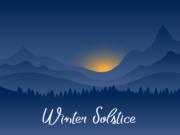
Winter Solstice
The Winter Solstice in 2025 for the Northern Hemisphere occurs on Sunday, December 21st at 10:03 a.m. EST, marking the shortest day and longest night, and the official start of winter. Although the winter solstice itself lasts only a moment, the term also refers to the day on which it occurs. The winter solstice is the day with the fewest hours of sunlight in the whole year, making it the “shortest day” of the year.
The word solstice is derived from the Latin word solstitium, meaning “the Sun’s standstill.” For a few days before and after the solstice, the Sun’s path across the sky appears to freeze. The change in its noontime elevation is so slight that the Sun’s path seems to stay the same, or stand still. The day after the winter solstice, the Sun’s path begins to advance northward again. Although the winter solstice means the start of winter, it also means the return of more sunlight!
Since ancient times, people all over the world have recognized this important astronomical occurrence and celebrated the subsequent “return” of the Sun in a variety of different ways. Old solstice traditions have influenced holidays we celebrate now, such as Christmas and Hanukkah. Some solstice traditions include:
Dong Zhi, the “arrival of winter,” is an important festival in China. It is a time for families to gather and celebrate their special occasions. The holiday traditionally falls between the 21st and 23rd of December on the Chinese calendar, but can also be celebrated in countries that have large Chinese-speaking populations. The festival is celebrated with fireworks, lanterns and feasts. It is said that the spirits of ancestors visit their families during Dong Zhi, so people like to light fireworks at night to make them happy. It is thought to have started as an end-of-harvest festival, when farmers returned home and celebrated with family.
Soyal is the winter solstice celebration of the Hopi Indians of northern Arizona. During this winter festival, the Hopi perform ceremonies which are intended to call the sun back from its winter sleep. The Hopi believe that the sun god has traveled far from the tribe on the solstice, so they use warriors and other powerful members of the tribe to coax the sun back. Soyal is also traditionally a time for purification and blessings, and it marks the turning of the year. In addition to performing specific ceremonies on Soyal, many Hopi also exchange gifts and well wishes.
St. Lucia’s Day is a festival of lights celebrated in Scandinavia around the time of the winter solstice. Although it is now meant to honor St. Lucia, a Christian saint, it has been incorporated with earlier Norse solstice traditions, such as lighting fires to ward off spirits during the longest night, and to bring light and warmth back into the world as it begins to grow dark.
Saturnalia, was one of the most popular holiday on the ancient Roman calendar, derived from older farming-related rituals of midwinter and the winter solstice, especially the practice of offering gifts to the gods during the winter sowing season. The ancient holiday is perhaps the most closely linked with the modern celebration of Christmas, which included games and feasts and gift-giving for several days.
The winter solstice can be a time of celebration and self-reflection. As the longest night of the year, it’s an opportunity to pause and assess what we’ve accomplished in our lives as well as set goals for coming years . This is a prime time for self-reflection and planning. It’s also a good time to reach out to friends and family members who might need support. The winter solstice can be an emotional time, especially as we consider what has passed this year and what lies ahead in the future. . It’s also a time to rejoice in the fact that we made it through the longest night and bask in the light of the sun as it starts its slow climb back up in the sky.
